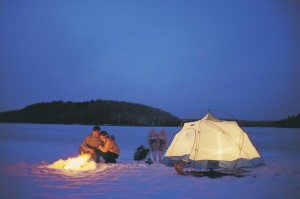Clothing
- Several thin layers of synthetic clothing.
- Wind-proof shell, such as a parka.
- Thin, synthetic socks with thick, wool socks over them.
- Waterproof boots, such as Mukluks, or rubber boots. Avoid steel-toed or leather boots.
- Gaiters to keep snow out of your boots.
- Wind-proof mittens over wool gloves.
- Wind-proof pants over wool or fleece pants. Do not wear jeans – cotton kills.
- Down-filled vest.
- Warm headgear. Your body loses most of its heat through the head, so keep it insulated!
Gear
- Sleeping bag, rated for the expected temperatures
- Sleeping mat made of closed cell foam will protect the camper from the cold ground. It should be considered essential for cold weather. They roll up about 6 inch diameter.
- Compass, map, and flashlight. It is illegal to venture into some areas without these essential items!
- Knife
- Personal toiletries
- First aid kit
- Small tents are easier to heat than large ones (and your body is the furnace) or you might build a snow cave.
- Sled, snowshoes, or cross-country skis.
- Rope
- Camping stove – make sure your stove will work in cold temperatures. Propane, butane, and alcohol stoves can be difficult (or impossible) to light at low temperatures. Wood-fueled camping stoves are strongly advised.
- Matches
- Cooking gear and utensils.
- Mess Kits (plate, cup, cutlery).
- Whistle (one for each member of the expedition).
- Water purification solution
Remember winter camping safety is even more important than in regular camping because the environment is more hostile.
Pitching a tent in winter conditions can pose a problem as anchoring the tent to the ground is more difficult. Winter winds tend to be stronger than summer winds, so securely anchoring the tent is even more important. Meanwhile, the ground is frozen, making it difficult to drive stakes into it. Also the ground may be buried deep beneath the snow.
When pitching a tent in snow, first stomp down an area as large as the tent. Level the ground if necessary by shifting move snow from the high side to the low side, or add other snow to level things out (can’t do that in the summer). Pack and smooth things out as quickly as possible because fluffy mounds of snow have a strange way of turning into bumpy chunks of ice very quickly. Chunks of ice are not fun to sleep on.
Then lay the tent out. Anchor the tent before erecting the poles if there is any wind to avoid it blowing away. To anchor the tent in the snow if you can’t get stakes into the ground, fill a bag with snow, ice, or rocks, and tie it to the tent’s anchor point, and bury the bag in the snow. Then pack the snow down firmly around the bag. Be sure to dig up the bags when you break camp. You can also consider anchoring to trees or heavy logs.
In deep snow, consider digging out a kitchen area and building up walls with the snow you scoop out of the kitchen hole to shelter your cooking and fire area. If you want to go further, dig a path from the kitchen to the tents, and build snow chairs and tables. These activities put you, your friends and your fire all below the snow and out of the wind.
Or, if you have a lot of time you could build something like this:



